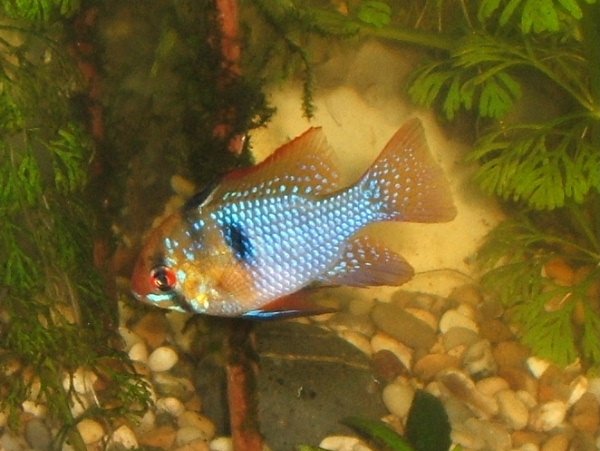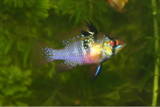|
Scientific Name: Mikrogeophagus ramirezi
Common Name: Ram
Synonyms: Papiliochromis ramirezi, Apistogramma ramirezi, blue ram, German blue ram, Dwarf butterfly cichlid
Order: Perciformes
Class: Actinopterygii
Family: Cichlidae
Subfamily: Geophaginae
Etymology: Myers and Harry, 1948
Origin: Orinoco river basin
Distribution: Vanazuella, Colombia
Size: 5cm / 2in, females slightly smaller.
Diet: Omnivorous: flakes, tablet, frozen, live and crustaceans.
Lifespan: 2-3 years for Czech or wild caught. 1-2 years for farmed.
Sexual dimorphism: Males have elongated second and third dorsal rays as well as more pointed dorsal fin. Females have
a red hue on their bellies as well as more rounded dorsal fins.
Swimming level: All.
Minimum Tank Size: 2x1x1 ft for a pair. If you want to keep more then a pair you need at least a 4x1x1 ft aquarium because
males are territorial.
Females:males ratio: 1:1 or more females then males. Males should not be kept together without females.
Tank Setup: Planted tank with soft substrate and some flat stones for them to spawn on.
Min / Max number in tank: Can be kept alone, but do better in pairs. Make sure that each pair has it's own territory which
is normally about 45-60cm in diameter.
Water parameters:
* Water Type: tropical freshwater
* Temp: 23 – 28°C
* pH: 5.0 - 7.0
* Hardness: up to 12°
Temperament: Peaceful, but territorial when breeding.
Compatibility: Placid community fish of simmilar size or smaller.
Breeding: A male and a female will pair up. They will then chose a spawning site usually in the form of a terracotta flower
pot piece or a stone with a diameter of at least 10cm. Once this is cleaned and the pair is ready to breed, the female will
lay the eggs and the male will fertilize them a few seconds later. The pair will them guard the eggs (one of the parents will
usually be within 5cm of them while the other will be guarding the area and looking for food). Once the fry hatch, their parents
will continue protecting them untill such a time that they will be able to fend for themselves. During this time, the pair
will move their offspring to different parts of the tank and might dig pits for them in the sandy substrate.
The eggs take 48-76 hours to hatch, after which time they take on a "larvae" form where the fry are no longer
eggs, but they are unable to swim. A few days later, they start "hopping" and are after finally able to swim. All
in all, this tansition take 5-7 days.
Rams have quirky characters with great personalities. They are a delicate fish who need good water conditions and placid
tank mates. When adding new specimens to the aquarium, always watch for whitespot for the first few days. They must not be
shipped under any conditions!!! because they are just too fragile and are very unlikely to survive.
they come from three main sources:
1. Wild: these are considered to be the best quality and can fetch very high prices.
2. From E.Europe (notably the Czech Rep. and Germany): the second best and usually cost about £8-12 each as they're very
good quality.
3. From SE Asia: These can cost as low as £5... they are usually weak and easily get ill.
There is also a range of artificial colour morphs which have been produced through line breeding. These fish tend to be
even more fragile because of inbreeding.
* Gold
* Balloon
A simmilar, but hardier species are the Bolivian Rams (Mikrogeophagus altispinosus)
text by Kittykat of allfishforums
| Male |

|
| by Kittykat |
| Female |

|
| by kittykat |
|

